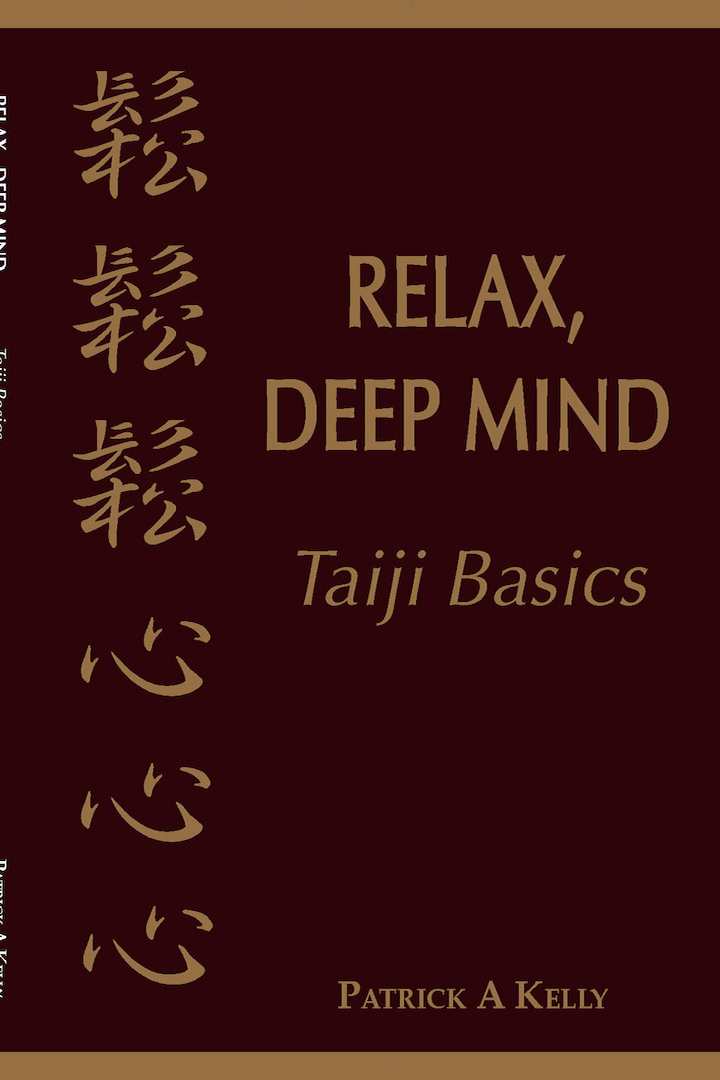Relax; Deepmind
revised

Relax, Deep Mind
This book covers the philosophy, principles and history of Taiji, along with a clear explanation of its practice methods.With nearly 200 detailed photographs, Patrick Kelly demonstrates Master Huang Xingxian's 5 loosening exercises and Grand Master Zheng Manqing's (Cheng Man-Ching's) 37-move short Yang form along with illustrated explanations of the basic pushing hands exercises.
¥200 Sfr35 US$35 €35 £30
BUY E-BOOK US$10
RelaxDeepMind.pdf (EN)
(revised 2021)
From the Back Cover:
"Taiji is an art where the soft overcomes the hard, the calm subdues the aggressive and the subtle transcends the gross. It is a method of bringing ourselves into harmony with ourselves, those people with whom we interact, and all the energies of our larger environment.Taiji Form develops internal strength. Pushing-hands develops sensitivity. Being externally relaxed while internally strong allows the possibility of resolving pressure without conflict.
Through building inner harmony and internal strength, together with physical relaxation and the philosophy of yielding, we gradually arrive at that place where the defence of the self in daily life no longer serves any purpose."
Table of Contents
1 What is Taiji?2 Taiji History
3 Taiji Today
4 Taiji Practice
5 Taiji Principles
6 5 Loosening Exercises
7 Short Form – 37 Move
8 Pushing Hands
9 Meditation
Appendix – Master Huang's 14 Important Points
Understanding
Understanding grows when knowledge combines with personal experience. The principles are explained in the Taiji Classics, but their truth must be experienced for ourselves. The understanding of these principles is not static. It becomes more subtle as our Taiji progresses. Humility is a consequence of growth in true understanding.Progress
It takes 3 to 4 years to learn a reasonably balanced set of forms and exercises. It takes another 3 to 4 years for these to become relaxed and naturally co-ordinated with the flow of energy in the body.The sequence of learning should be from big to small and from external to internal. Each process occurs in cycles where progress produces spirals. The repeated action of extending and condensing, refines the ideas and methods like the working of rough iron into finest spring steel.
Most cells in the body replace themselves within a 7 to 8 year cycle. The cells that form while practising Taiji contain the essence of that practice so that a completely new 'Taiji body' is formed by the end of a 7 to 8 year period, though it will be still capable of much physical refinement.
Training the Mind takes a further 7 to 8 years for similar reasons. This achieves the 'second change'. Really this stage is using the Mind to train the Lower-energies. After about 14 years the 'Taiji Mind' or 'Deep Mind' should be apparent. Under ideal conditions a further 7 to 8 years allows the Spirit to gradually infuse the Deep Mind and the 'third change' occurs.
Effort
Effort to change calls forth resistance, producing friction or struggle, which generates the heat or energy, required to produce inner refinement.Maintaining a steady, flexible intention in the face of this resistance, directs the effort.
An attitude of acceptance handles unchangeable effects from the past, and prevents the resistance that appears in response to effort, from consuming the energy produced by the struggle.
An internal state of self-awareness provides objectivity, taking us outside the learning process as it is occurring.
Health
Practising Taiji strengthens the basic energy of the body. Health relates mainly to the condition of the energy flow in our body, but includes the state of all our internal organs. Taiji fortifies the internal organs by promoting the circulation of blood and other body fluids. Practising Taiji also strengthens the muscles and bones. This provides protection from external injury and allows for more effective daily living.Some confuse weak with soft, therefore good, and strong with hard, therefore bad. While the good are often weak and the bad are sometimes strong, this is just an unfortunate fact of life. The Taiji ideal is both soft and strong.
Minor problems may arise in the course of training. Shaking legs, aching muscles, or dull pains in the ankles and feet, often occur as the body adjusts to a new exercise. Dizziness and mild nausea occasionally appear from the initial efforts to concentrate the Mind. Knee pain is common but careful attention to knee alignment, combined with massage before and after training, will minimise it.
Overemphasising the fighting or competitive aspect often leads to body damage. If any difficulties do persist, discuss them with your instructor or senior students who will have personal experience in the exercises and should understand the causes. Pains in the body are just one type of resistance that may occur when we try to move in a new way.
Each person should decide for themselves, up to what intensity they can be safely accepted. The health of the body is only as important in Taiji, as is the health of the brain important in developing the intellect.
Three Levels
Taiji practice has 3 levels. Body, Mind and Spirit (Earth, Man and Heaven). The Mind in its deepest aspect (Deep Mind) is central to the training process. There are 2 connections to be trained - Mind/body and Mind/Spirit.The Mind and the body are connected by the lower energies which has 3 aspects - etheric, emotional and mental. Training the Mind/body connection has 2 components - moving with awareness (body active, Mind passive), and leading the movement with the Mind (Mind active, body passive).
We are born with functioning bodies providing a degree of awareness, but little moving, feeling or thinking control. Living in life forces some development in these areas, but the potential of each person lies far beyond what they usually attain.
Taiji is designed to develop both active and passive components of the Mind/body connection, with a balanced consideration for the 3 aspects of the lower energies. The Mind and the Spirit are connected by the higher energies.
Training of the Mind/Spirit connection also has 2 components - deep awareness (Deep Mind active), and response within the Deep Mind to subtle direction from the Spirit (Deep Mind passive). Training the Mind/Spirit connection naturally assumes its importance once the training of the Mind/body connection nears its completion.
Motive
There are three reasons for practising - firstly to help ourselves; secondly to be involved with others who also wish to practice; thirdly to contribute something to the source of the teaching. Receiving, sharing and giving support each other.Each of these three has many levels. People choose their own level of practice according to their inner motives, though motives - conscious and unconscious - are usually mixed.
The level or quality is decided firstly by the intention, then by the feeling behind it, and lastly by the skill or ability with which it is carried through.
Ego
Training the body produces change, but with each change comes the need for its psychological integration. The ego's response to success or temporary failure, affects the learning process.Conflict may arise between the unrealistic expectations stemming from the imaginary picture we have of ourselves, and the dawning realisation of where we are and what needs to be done.
The ego is a shell, a 'Shop Front' to protect our delicate inner life from the outer world. On a superficial level it prevents those around us from seeing who we really are. On a deeper and more harmful side it blocks our contact with our Deep Mind.
Sensitive pressure applied by the teacher, the teaching and the student themselves, combine to break through the areas of resistance and conflict, increasing the students inner freedom. Well established and outwardly natural 'Fronts' are often the hardest to crack.
Deep Changes
At the time of practice good effects can be experienced in the way of body looseness, increased awareness, greater energy flow and peace of Mind. Such short term results come easily when we practice and disappear easily when we do not practice. They heal the infirm and balance the unstable.Deep changes take time to mature. They require constant effort over a long period. They affect our essence and alter who we are. Commonly, people work intensively for some time and then, because the results are not immediately obvious, they stop. The inner progress will have been occurring but will not yet have surfaced.
Deep changes are not easily lost, and if intense enough, they crystallise and become permanent.
Practice Space
The external environment is of limited importance. Special shoes, a neat uniform, a beautiful room or a quiet park with trees and grass, can be pleasant. Yet pleasant or unpleasant, either way the effect is minor once the practitioner begins to mature inwardly and the release from dependence on external conditions starts to appear.Although using one physical place over and over can accumulate energy in that space itself, this is the lowest level at which the environment begins to be important. While helpful, it may also breed dependence on external conditions.
In a broader sense, our environment is the life situation that we place ourselves in. This is perhaps 90% determined by our past actions and 10% determined by our present actions. A 'good' life situation may not contribute much to inner development, but a 'bad' one can interfere with it by sapping and diverting physical, emotional and mental energy.
The group energy field is the most important feature of the practice conditions. Everybody makes their contribution to this field by the quality and quantity of effort they provide, while everybody receives its stimulation during practice.
Which Teacher?
A teacher is no more than a student at a later stage of development than the people whom they are teaching. Teachers express their personal understanding of the Taiji principles, varying their teaching with time to suit the circumstances and people involved.Each student understands what is taught in their own particular way. When students have studied for 10 years with a good teacher, they will understand what that teacher is trying to express, although it will take at least that time again to make it their own.
First look for a teacher who has trained for at least this length of time, or an instructor who is still under the direction of such a teacher. Then consider the lineage or quality of the Taiji the teacher or instructor has been taught, and the teacher's nature or ability to accurately express the teaching. Lastly consider how openly the teacher gives out that teaching.
The end result of these factors can be seen in the quality of the students that the teacher has attracted, and the atmosphere generated in the classes. Ultimately, the source of Taiji is higher than any teacher.
Taiji cannot be sold and cannot be bought. Teachers hold it in trust for those who, due to their efforts, are in a position to receive it. Any money paid is for the teacher's time and expenses.
There exists a natural intelligence supporting the learning of Taiji. This is more important than any teacher. As your understanding grows, practise what you find to be true and you will be loyal to Taiji. Then you will also be loyal to any teacher who is in harmony with this Natural Intelligence.
